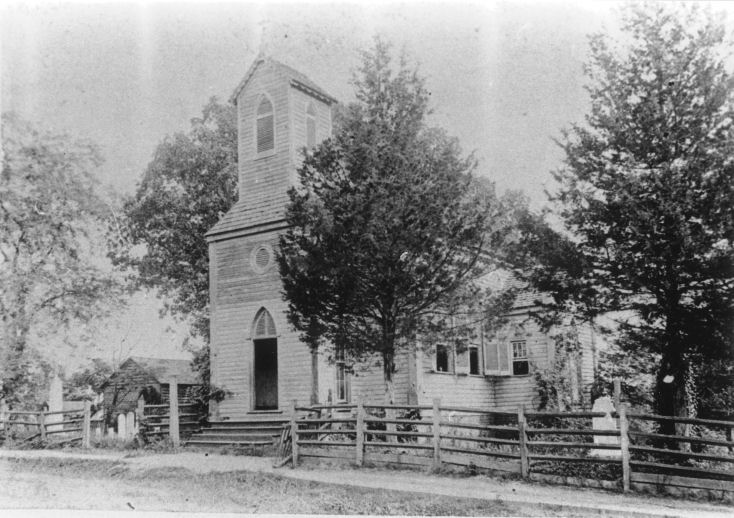Grace Episcopal Church
- A Brief History -

Morganton's Grace Episcopal Church, considered a "mother church" in this region, traces its roots to the first Episcopal Church in western North Carolina - St. Andrew's Mission; it was established in 1821, on the site of the present First Baptist Church in what is now the Town of Hudson (Caldwell County). St. Andrew's was founded by Robert Johnstone Miller, commonly known as "Parson Miller" who would be the earliest evangelist of not one, but two, denominations in this part of the state. At that time there were only four Episcopal churches in all of North Carolina.
Parson Miller was the first man ordained by the Lutheran Synod of North Carolina, and later, the first man ordained by the Episcopal Diocese of North Carolina.
Parson Miller married a daughter of Burke County pioneer "Gentleman John" Perkins. After Miller's death in 1831, a group of Episcopalians worshipped at a chapel located on the John's River near the Perkins home. Another handful of like-minded Episcopalians met at the old Meeting House in Morganton, and later, at the Burke County Courthouse.
A succession of seven missioners, most of whom left the area after short periods due to the strain of labor or ill health, guided the residentially-scattered forebears of Grace Church toward admission to the diocese of North Carolina on May 22, 1845. Twenty-two households, among them a slave, are listed among those of the parish's first register.
In 1846, a lot was purchased on the corner of King and McDowell streets and construction began on a clapboard church, seating about 50 people. It was consecrated July 10, 1847. John Collett, James Avery and Joseph J. Erwin were the first wardens. By 1858 Thomas Walton became senior warden and led the parish in that capacity until his death in 1905.
Except for Hannah, the slave, Grace Episcopal Church's first members represented the landed gentry of Burke County and its first rectors enjoyed personal wealth. After the Civil War, the parish - like much of Burke County - endured financial hardships for several decades.
By the 1890s, however, members decided that the old church was "not sufficiently grand, architecturally," and a new church — built of native granite cut from a Burke County quarry and finished "rubble style" — was constructed. The church was consecrated Nov. 22, 1896. About the same time a new and visionary rector, the Rev. Churchill Satterlee, arrived; he who would change the focus and spiritual depth of the congregation forever.
Under Satterlee's leadership, the church was re-born, in practice and in spirit. Members began to live out their baptismal vows, and under the umbrella of the Brotherhood of St. Andrew, committed themselves to a bold venture in outreach.
Satterlee established five holistic missions in Burke county to provide worship, schooling and some limited health care. His successors began six more missions, most of which included a chapel and a school, and in some instances a mission house for the teachers. With the advent of the public school system and better roads throughout the county, by 1935 most of the missions had closed. The two surviving missions - now full-fledged Episcopal parishes in their own right - are St. Mary's and St. Paul's. Another Morganton parish, St. Stephen's, originally located on McDowell Street across from Grace Church Cemetery, was begun in 1891 as a mission for African-Americans.
In 1906, the Rev. Walter Hughson, another Grace Church rector, and his activist wife, Mary Hughson, teamed with missionary nurse Maria Allen and physician Dr. Edward Phifer to form Grace Hospital on the old Mumford property on King Street, across from the then-Grace Church rectory.
This call to serve the community was additionally carried out in a number of other ministries birthed through Grace Church and/or its members throughout most of the next century: the first Red Cross chapter in Burke County, the first Boy Scout troop, the Community Chest (now United Way), Burke United Christian Ministries, Hospice, and Habitat for Humanity, as well as the first Boy Scout troop for the deaf in the United States. Grace Church's commitment to service has often been disproportionately large in comparison to its size. But many members continue their involvement and work for these and many other helping and service agencies in the community.
Today, the Grace Church complex occupies the entire east side of the 300 block of South King Street. The church proper houses the largest and finest collection of stained glass windows in the county and it is listed on the National Register of Historic Places.
Above all, Grace Church continues to offer to all people a safe and sacred place for worship, service and learning, always striving to follow its mission statement: "We are a community of Christ the servant."
- Eugene Willard
March 30, 2001
Grace Episcopal Church © 2008